Wim Wenseleers - Research

Wim Wenseleers started his research at the University of Antwerp (Experimental Solid State and
Laser Physics lab of Prof. D. Schoemaker, Prof. E. Goovaerts and Prof. A. Bouwen) as
an undergraduate studying
ultrafast processes in color centers in alkali halides.
Later, as a PhD student, he worked on
organic materials for nonlinear optics. As a post-doc at the University
of Arizona (Optical Materials and Technology Laboratory of Prof. J.W. Perry and Prof. S.R. Marder)
he worked on the design of organic
two-photon absorbing materials and their applications. From 2002-2008 he was
investigating organic nonlinear optics at the University of Antwerp in the ECM lab of Profs. Goovaerts
and Bouwen as a Postdoctoral Fellow of the Fund for Scientific Research - Flanders (Belgium)(F.W.O. - Vlaanderen). In 2008 W. Wenseleers was appointed a tenure track research professor position, and got tenured in october 2011.
Currently, his two main research lines are the preparation and spectroscopy of carbon nanotubes and other nanostructured materials, and the wavelength dependent investigation of organic nonlinear optics.
Conjugated molecular systems, especially in polymer materials, are promising novel optical materials.
Characterisation of organic molecules designed to possess high non-linear
optical (NLO) polarisabilities is performed with the EFISHG and hyper-Rayleigh techniques, using a unique setup based on a picosecond chirped pulse laser amplifier with OPA for automated wavelength-dependent NLO characterisation.
- Third order nonlinear optical polarisability induced by real electronic
excitations in transition metal diimine and dithiolene complexes.
W. Wenseleers, E. Goovaerts, A.S. Dhindsa, A.E. Underhill
in : Chemical Physics Letters, 254 (1996), p.410-414.
(abstract)
PDF
- Highly Dipolar, Optically Nonlinear Adducts of
Tetracyano-p-quinodimethane: Synthesis, Physical
Characterization, and Theoretical Aspects
Marek Szablewski, Philip R. Thomas, Anna Thornton,
David Bloor and Graham H. Cross, Jacqueline M. Cole,
Judith A.K. Howard, Massimo Malagoli, Fabienne Meyers,
Jean-Luc Brédas, Wim Wenseleers and Etienne Goovaerts
in : Journal of the American Chemical Society, 119:13 (1997), p.3144-3154.
(abstract)
PDF
- Organometallic nickel(II) complexes with
substituted benzo-nitrile ligands. Synthesis, electrochemical studies and
non-linear optical properties. The X-ray crystal structure of
[Ni(&eta5-C5H5){P(C6H5)3}(NCC6H4NH2)][PF6].
Alberto R. Dias, M. Helena Garcia, Paulo Mendes, M. Fátima M. Piedade,
M. Teresa Duarte, Maria J. Calhorda, Carlo Mealli, W. Wenseleers,
A.W. Gerbrandij and Etienne Goovaerts
in : Journal of Organometallic Chemistry, 553:1-2 (1998), p.115-128.
PDF
- Hyper-Rayleigh scattering study of &eta5-monocyclopentadienyl-metal
complexes for second order non-linear optical materials
Wim Wenseleers, Abraham W. Gerbrandij, Etienne Goovaerts, M. Helena Garcia, M. Paula Robalo,
Paulo J. Mendes, João C. Rodrigues, Alberto R. Dias
in : Journal of Materials Chemistry, 8:4 (1998), p.925-930.
PDF
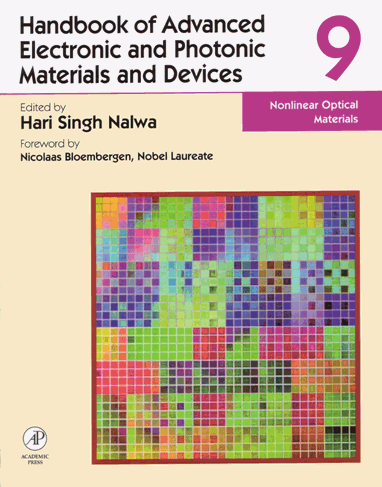
|
Design and Characterization of Organic and Organometallic Molecules for Second Order Nonlinear Optics.
E. Goovaerts, W.E. Wenseleers, M.H. Garcia and G.H. Cross
Chapter 3 in: Handbook of Advanced Electronic and Photonic Materials and Devices, Ed. Hari Singh Nalwa,
Volume 9: Nonlinear Optical Materials, p. 127-191 (Academic Press, San Diego, 2001, ISBN 0-12-513759-1).
View this chapter
and buy the entire handbook via amazon.com !
|
- Organometallic complexes for
second-order nonlinear optics: synthesis and molecular quadratic hyperpolarisabilities
of &eta5-monocyclopentadienyl
iron(II) nitrile derivatives with different phosphines. X-ray crystal structure of
[FeCp(DPPE)(p-NCC6H4NO2)] [PF6].CH2Cl2
M. Helena Garcia, M. Paula Robalo, A.R. Dias, M. Fátima M. Piedade,
Adelino Galvão, Wim Wenseleers and Etienne Goovaerts
in : Journal of Organometallic Chemistry, 619 (2001), p.252-264.
PDF
- Synthesis and nonlinear optical properties of &eta5-monocyclopentadienyl iron(II) acetylide derivatives. X-ray
crystal structures of [Fe(&eta5-C5H5)(DPPE)(p-C≡CC6H4NO2)] and
[Fe(&eta5-C5H5) (DPPE)((E)-p-C≡CC6H4C(H)=C(H)C6H4NO2)]
M.H. Garcia, M.P. Robalo, A.R. Dias, M.T. Duarte, W. Wenseleers, G. Aerts,
E. Goovaerts, M.P. Cifuentes, S. Hurst, M.G. Humphrey, M. Samoc and B. Luther-Davies
in : Organometallics, 21 (2002), p.2107-2118.
PDF
- High First Hyperpolarizability and Perfectly Aligned Crystal Packing for an Organometallic Compound [Fe(&eta5-C5H5)((R)-PROPHOS)(p-NC6H4NO2)][PF6].CH2Cl2
W. Wenseleers, E. Goovaerts, P. Hepp, M.H. Garcia, M.P. Robalo, A.R. Dias, M.F.M. Piedade & M.T. Duarte
in : Chemical Physics Letters, 367:3-4 (2003), p.390-397.
PDF
- Synthesis and Properties of Zwitterionic Nonlinear Optical Chromophores with Large Hyperpolarizability for Poled Polymer Applications.
A.M.R. Beaudin, N.H. Song, Y.W. Bai, L.Q. Men, J.P. Gao, Z.Y. Wang, M. Szablewski, G. Cross, W. Wenseleers, J. Campo, E. Goovaerts
in : Chemistry of Materials, 18 (2006), p.1079-1084.
PDF
- Synthesis, Characterisation and Molecular Hyperpolarisabilities of Pseudo-Octahedral Hydrido(nitrile)iron(II) Complexes for Nonlinear Optics: X-ray Structure of [Fe(H)(dppe)2(4-NCC6H4NO2)][PF6]·CH2Cl2.
M.P. Robalo, A.P.S. Teixeira, M.H. Garcia, M.F.M. da Piedade, M.T. Duarte, A.R. Dias, J. Campo, W. Wenseleers, E. Goovaerts
in : European Journal of Inorganic Chemistry, 2006(11), p.2175-2185.
PDF
- Compromise between conjugation length and charge-transfer in nonlinear optical &eta5-monocyclopentadienyliron(II) complexes with substituted oligo-thiophene nitrile ligands: synthesis, electrochemical studies and first hyperpolarizabilities
M.H. Garcia, P.J. Mendes, M.P. Robalo, A.R. Dias, J.Campo, W. Wenseleers, E. Goovaerts
in : Journal of Organometallic Chemistry, 692:14 (2007), p.3027-3041.
PDF
- Accurate Determination and Modeling of the Dispersion of the First Hyperpolarizability of an Efficient Zwitterionic Nonlinear Optical Chromophore by Tunable Wavelength Hyper-Rayleigh Scattering
J. Campo, W. Wenseleers, E. Goovaerts, M. Szablewski, G.H. Cross
in : Journal of Physical Chemistry C, 112:1 (2008), p.287-296.
PDF
- Functionalized Picolinium Quinodimethane Chromophores for Electro-Optics: Synthesis, Aggregation Behavior, and Nonlinear Optical Properties.
Y. Xiong, H.D. Tang, J.D. Zhang, Z.Y. Wang, J. Campo, W. Wenseleers, E. Goovaerts
in : Chemistry of Materials, 20:24 (2008), p.7465-7473.
- Synthesis and structural characterization of ruthenium(II) and iron(II) complexes containing 1,2-di-(2-thienyl)-ethene derived ligands as chromophores.
M.H. Garcia, P. Florindo, M.F.M. Piedade, M.T. Duarte, M.P. Robalo, E. Goovaerts, W. Wenseleers
in : Journal of Organometallic Chemistry, 694:3 (2009), p.433-445.
- Highly sensitive setup for tunable wavelength hyper-Rayleigh scattering with parallel detection and calibration data for various solvents.
J. Campo, F. Desmet, W. Wenseleers, E. Goovaerts
in : Optics Express, 17:6 (2009), p.4587-4604.
PDF
- First Hyperpolarizability Dispersion of the Octupolar Molecule Crystal Violet: Multiple Resonances and Vibrational and Solvation Effects
Jochen Campo, Anna Painelli, Francesca Terenziani, Tanguy Van Regemorter, David Beljonne, Etienne Goovaerts, Wim Wenseleers
in : Journal of the American Chemical Society, 132:46 (2010), p.16467-16478.
Abstract
- Practical Model for First Hyperpolarizability Dispersion Accounting for Both Homogeneous and Inhomogeneous Broadening Effects
J. Campo, W. Wenseleers, J.M. Hales, N.S. Makarov, J.W. Perry
in : Journal of Physical Chemistry Letters, 3:16 (2012), p.2248-2252.
DOI: 10.1021/jz300922r
- Divergent Route to the Preparation of Hybrid Pt-Fe 2,4,6-Tris(4-ethynyl)phenyl-1,3,5-triazine Metallodendrimers for Nonlinear Optics
K. Maiti, M.G. Jardim, J.C. Rodrigues, K. Rissanen, J. Campo, W. Wenseleers
in : Organometallics, 32:2 (2013), p.406-414.
Abstract
-
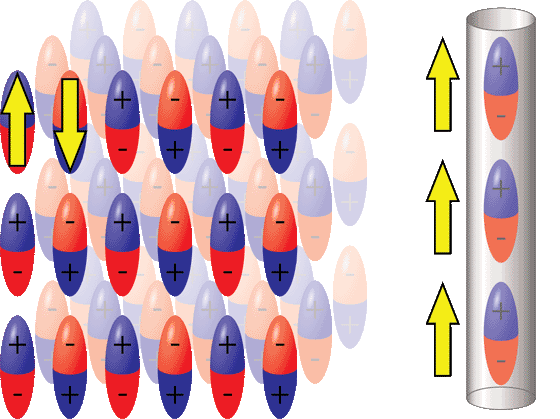
| Asymmetric dyes align inside carbon nanotubes to yield a large nonlinear optical response
S. Cambré, J. Campo, C. Beirnaert, C. Verlackt, P. Cool, W. Wenseleers
in : Nature Nanotechnology 10(3) (2015), p.248-252., 10:3 (2015), p.248-252.
DOI: 10.1038/NNANO.2015.1
PDF
See also the following news articles about this work:
News&Views article in 
Research Highlight in 
News article on Pro-Physik.de (in German).
|

- N-Methylquinolinium derivatives for photonic applications: Enhancement of electron-withdrawing character beyond that of the widely-used N-methylpyridinium
J.-H. Jeong, J.-S. Kim, J. Campo, S.-H. Lee, W.-Y. Jeon, W. Wenseleers, M. Jazbinsek, H. Yun, O. P. Kwon
in : Dyes and Pigments, 113 (2015), p.8.
DOI:10.1016/j.dyepig.2014.07.016
- Organic Compounds with Large and High-Contrast pH-Switchable Nonlinear Optical Response
S. van Bezouw, J. Campo, S.-H. Lee, O. P. Kwon, W. Wenseleers
in : Journal of Physical Chemistry C, 119:37 (2015), pp 21658–21663.
DOI:10.1021/acs.jpcc.5b06968
This study aims at the design of organic chromophores and materials with strong
two-photon absorption, and at the further development of applications of two-photon absorption.
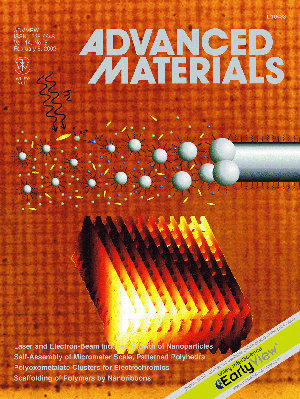
| Laser and Electron-Beam Induced Growth of Nanoparticles for 2D
and 3D Metal Patterning
F. Stellacci, C.A. Bauer, T. Meyer-Friedrichsen, W. Wenseleers, V. Alain, S.M. Kuebler, S.J.K. Pond,
Y. Zhang, S.R. Marder and J.W. Perry
in: Advanced Materials, 14:3 (2002), p.194-198.
PDF
Cover: Metallic nanostructures such as that displayed on the cover (bottom image and background)
can be fabricated in nanoparticle-seeded polymer nanocomposites by either two-photon laser exposure
(schematically illustrated on the cover) or electron-beam irradiation. Full details are to be
found in the article by Perry, Marder and co-workers on page 194.
A news article about this work also appeared in Chemical & Engineering News.
|
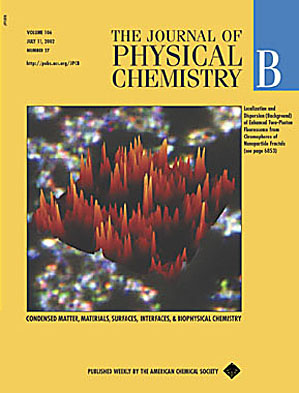
| Five Orders-of-Magnitude Enhancement of Two-Photon Absorption for Dyes on
Silver Nanoparticle Fractal Clusters
W. Wenseleers, F. Stellacci, T. Meyer-Friedrichsen, T. Mangel, C.A. Bauer, S.J.K. Pond, S.R. Marder and J.W. Perry
in : Journal of Physical Chemistry B, 106:27 (2002), p.6853-6863.
PDF
On the cover: Localization and dispersion (background) of enhanced two-photon fluorescence
from chromophores on nanoparticle fractals (see page 6853).
|
- Photoresponsive Hydrogel Microstructure Fabricated by Two-Photon Initiated Polymerization
Toshiyuki Watanabe, Megumi Akiyama, Kenro Totani, Stephen M. Kuebler, Francesco Stellacci,
Wim Wenseleers, Kevin Braun, Seth R. Marder, and Joseph W. Perry
in : Advanced Functional Materials, 12:9 (2002), p.611-614.
PDF
- Role of Dimensionality on the Two-Photon Absorption Response of
Conjugated Molecules: The Case of Octupolar Compounds
D. Beljonne, W. Wenseleers, E. Zojer, Z. Shuai, H. Vogel, S.J.K. Pond, J.W. Perry, S.R. Marder and J.-L. Brédas
in : Advanced Functional Materials, 12:9 (2002), p.631-641.
PDF
- Ultrabright Supramolecular Beacons based on the Self-Assembly of Chromophores on Metal Nanoparticles
F. Stellacci, C.A. Bauer, T. Meyer-Friedrichsen, W. Wenseleers, S.R. Marder and J.W. Perry
in : Journal of the American Chemical Society, 125 (2003), p.328-329.
PDF
- Bis(dioxaborine) compounds with large two-photon cross sections, and
their use in the photodeposition of silver
Marcus Halik, Wim Wenseleers, Cara Grasso, Francesco Stellacci, Egbert Zojer, Stephen
Barlow, Jean-Luc Brédas, Joseph W. Perry and Seth R. Marder
in : Chemical Communications, 2003, p.1490-1491.
PDF
- Limitations of Essential-State Models for the Description of Two-Photon
Absorption Processes: The Example of Bis(dioxaborine)-Substituted Chromophores
Egbert Zojer, Wim Wenseleers, Peter Pacher, Stephen Barlow, Marcus Halik, Cara Grasso,
Joseph W. Perry, Seth R. Marder & Jean-Luc Brédas
in : Journal of Physical Chemistry B, 108:25 (2004), p.8641-8646.
PDF
- Two-Photon Absorption in Linear Bis-dioxaborine Compounds - The Impact of Correlation-Induced Oscillator-Strength Redistribution
Egbert Zojer, Wim Wenseleers, Marcus Halik, Cara Grasso, Stephen Barlow,
Joseph W. Perry, Seth R. Marder & Jean-Luc Brédas
in : ChemPhysChem, 5:7 (2004), p.982-988.
PDF
In collaboration with Dr. K. Ramser (Göteborgs University; currently at Luleĺ University of Technology), and the groups of Prof. S. van Doorslaer (SIBAC lab, UA), and Prof. L. Moens (Biochemistry dept., UA), optical spectroscopic techniques (e.g. resonant Raman spectroscopy combined with optical tweezers)for the in vitro and in vivo study of biological systems are developed, and applied to the study of heme proteins.
- A combined micro-resonance Raman and absorption set-up enabling in vivo studies under
varying physiological conditions: The nerve globin in the nerve cord of Aphrodite aculeata
K. Ramser, W. Wenseleers, S. Dewilde, S. Van Doorslaer, L. Moens, D. Hanstorp
in : Journal of Biochemical and Biophysical Methods, 70:4 (2007), p.627-633.
(as of 2008, title changed to Journal of Proteomics)
PDF
- Micro-resonance Raman study of optically trapped Escherichia coli cells
overexpressing human neuroglobin
K. Ramser, W. Wenseleers, S. Dewilde, S. Van Doorslaer, L. Moens, D. Hanstorp
in : Journal of Biomedical Optics, 12:4 (2007), 044009.
PDF
Carbon nanotubes are new materials with unique mechanical, electronic, and optical properties. Potential
applications range from ultrastrong composite materials to solar cells, nanoelectromechanical devices (NEMS), molecular sensors, field effect transistors etc. However, in actually realising such applications, their processability has been a major obstacle. We explore the solubilization of nanotubes using surfactants, and study their properties by means of various spectroscopic techniques. In particular, our discovery that
natural bile salt detergents (the molecules that are present in our intestines to help in digesting fats !) are
unusually effective at isolating and "dissolving" nanotubes in water has opened a whole new range of possibilities.
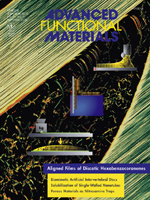
| Efficient Isolation and Solubilization of Pristine Single-Walled Nanotubes in Bile Salt Micelles
W. Wenseleers, I.I. Vlasov, E. Goovaerts, E.D. Obraztsova, A.S. Lobach, A. Bouwen
in: Advanced Functional Materials, 14:11 (2004), p.1105-1112.
PDF
Editorial: Various surfactants are investigated for solubilizing individual intact single-walled
nanotubes (SWNTs) without chemical/ultrasonic treatment. Wenseleers and coworkers demonstrate on p.1105 that
bile salt detergents are very efficient at solubilizing pristine SWNTs. Their micelles form an unusually
unperturbed environment, resulting in highly resolved optical absorption spectra, bright band-gap
fluorescence, and unprecedented resolution (~2.5 cm-1) of radial breathing modes in Raman spectra.
|
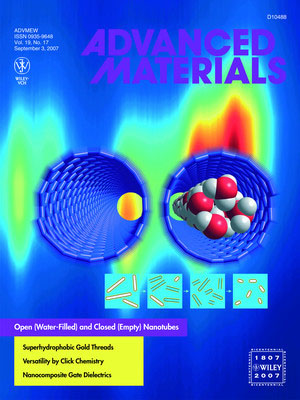
| Effect of Water Filling on the Electronic and Vibrational Resonances of Carbon Nanotubes: Characterizing Tube Opening by Raman Spectroscopy.
W. Wenseleers, S. Cambré, J. Culin, A. Bouwen, E. Goovaerts
in : Advanced Materials, 19:17 (2007), p.2274-2278.
PDF
Also featured in  ! !
|
- Characterisation of Nanohybrids of Porphyrins with Metallic and Semiconducting Carbon Nanotubes by EPR and Optical Spectroscopy
Sofie Cambré, Wim Wenseleers, Jelena Culin, Sabine Van Doorslaer, Antonio Fonseca, Janos B.Nagy, Etienne Goovaerts
in : ChemPhysChem, 9:7 (2008), p.1930-1941.
Abstract
PDF
- Endohedral Copper(II)acetylacetonate/ Single-Walled Carbon Nanotube Hybrids Characterized by Electron Paramagnetic Resonance
Sofie Cambré, Wim Wenseleers, Etienne Goovaerts
in : Journal of Physical Chemistry C (Nanomaterials and Interfaces), 113:31 (2009), p.13505-13514.
Abstract
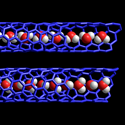
| Experimental Observation of Single-File Water Filling of Thin Single-Wall Carbon Nanotubes down to Chiral Index (5,3)
Sofie Cambré, Bob Schoeters, Sten Luyckx, Etienne Goovaerts, Wim Wenseleers
in : Physical Review Letters, 104:20 (2010), 207401.
Abstract
|
- Determination of the Metallic/Semiconducting Ratio in Bulk Single-Wall Carbon Nanotube Samples by Cobalt Porphyrin Probe Electron Paramagnetic Resonance Spectroscopy
Sofie Cambré, Wim Wenseleers, Etienne Goovaerts, Daniel E. Resasco
in : ACS Nano, 4:11 (2010), p.6717-6724.
Abstract
-
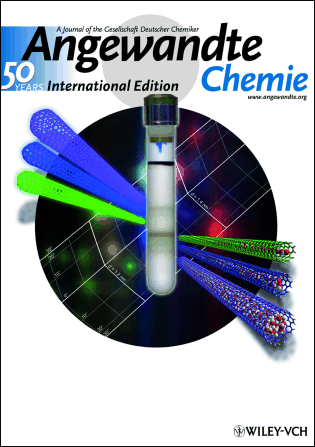
| Separation and Diameter-Sorting of Empty (End-Capped) and Water-Filled (Open) Carbon Nanotubes by Density Gradient Ultracentrifugation
S. Cambré, W. Wenseleers
in : Angewandte Chemie International Edition, 50:12 (2011), p.2764-2768.
Abstract
PDF
|
- Luminescence Properties of Individual Empty and Water-Filled Single-Walled Carbon Nanotubes
Sofie Cambré, Silvia M. Santos, Wim Wenseleers, Ahmad R. T. Nugraha, Riichiro Saito, Laurent Cognet, Brahim Lounis
in : ACS Nano, 6:3 (2012), p.2649-2655.
Abstract
-

| Asymmetric dyes align inside carbon nanotubes to yield a large nonlinear optical response
S. Cambré, J. Campo, C. Beirnaert, C. Verlackt, P. Cool, W. Wenseleers
in : Nature Nanotechnology 10(3) (2015), p.248-252., 10:3 (2015), p.248-252.
DOI: 10.1038/NNANO.2015.1
PDF
See also the following news articles about this work:
News&Views article in 
Research Highlight in 
News article on Pro-Physik.de (in German).
|

- Chirality-dependent mechanical response of empty and water-filled single-wall carbon nanotubes at high pressure
A.C. Torres-Dias, S. Cambré, W. Wenseleers, D. Machon, A. San-Miguel
in : Carbon, 95 (2015), 442-451.
DOI: 10.1016/j.carbon.2015.08.032
- Chirality-dependent densities of carbon nanotubes by in situ 2D fluorescence-excitation and Raman characterisation in a density gradient after ultracentrifugation
Sofie Cambré, Pieter Muyshondt, Remi Federicci, Wim Wenseleers
in : Nanoscale, 7 (2015), p.20015-20024.
PDF

| Laser and Electron-Beam Induced Growth of Nanoparticles for 2D
and 3D Metal Patterning
F. Stellacci, C.A. Bauer, T. Meyer-Friedrichsen, W. Wenseleers, V. Alain, S.M. Kuebler, S.J.K. Pond,
Y. Zhang, S.R. Marder and J.W. Perry
in: Advanced Materials, 14:3 (2002), p.194-198.
PDF
Cover: Metallic nanostructures such as that displayed on the cover (bottom image and background)
can be fabricated in nanoparticle-seeded polymer nanocomposites by either two-photon laser exposure
(schematically illustrated on the cover) or electron-beam irradiation. Full details are to be
found in the article by Perry, Marder and co-workers on page 194.
A news article about this work also appeared in Chemical & Engineering News.
|

| Five Orders-of-Magnitude Enhancement of Two-Photon Absorption for Dyes on
Silver Nanoparticle Fractal Clusters
W. Wenseleers, F. Stellacci, T. Meyer-Friedrichsen, T. Mangel, C.A. Bauer, S.J.K. Pond, S.R. Marder and J.W. Perry
in : Journal of Physical Chemistry B, 106:27 (2002), p.6853-6863.
PDF
On the cover: Localization and dispersion (background) of enhanced two-photon fluorescence
from chromophores on nanoparticle fractals (see page 6853).
|
- Ultrabright Supramolecular Beacons based on the Self-Assembly of Chromophores on Metal Nanoparticles
F. Stellacci, C.A. Bauer, T. Meyer-Friedrichsen, W. Wenseleers, S.R. Marder and J.W. Perry
in : Journal of the American Chemical Society, 125 (2003), p.328-329.
PDF
- Bis(dioxaborine) compounds with large two-photon cross sections, and
their use in the photodeposition of silver
Marcus Halik, Wim Wenseleers, Cara Grasso, Francesco Stellacci, Egbert Zojer, Stephen
Barlow, Jean-Luc Brédas, Joseph W. Perry and Seth R. Marder
in : Chemical Communications, 2003, p.1490-1491.
PDF
- Silver Nanoparticles with Broad Multi-Band Linear Optical Absorption
O.M. Bakr, V. Amendola, C.M. Aikens, W. Wenseleers, R. Li, L. Dal Negro, G.C. Schatz, F. Stellacci
in : Angewandte Chemie International Edition, 48:32 (2009), p.5921-5926.
Back to the ECM Home Page.







 !
!





